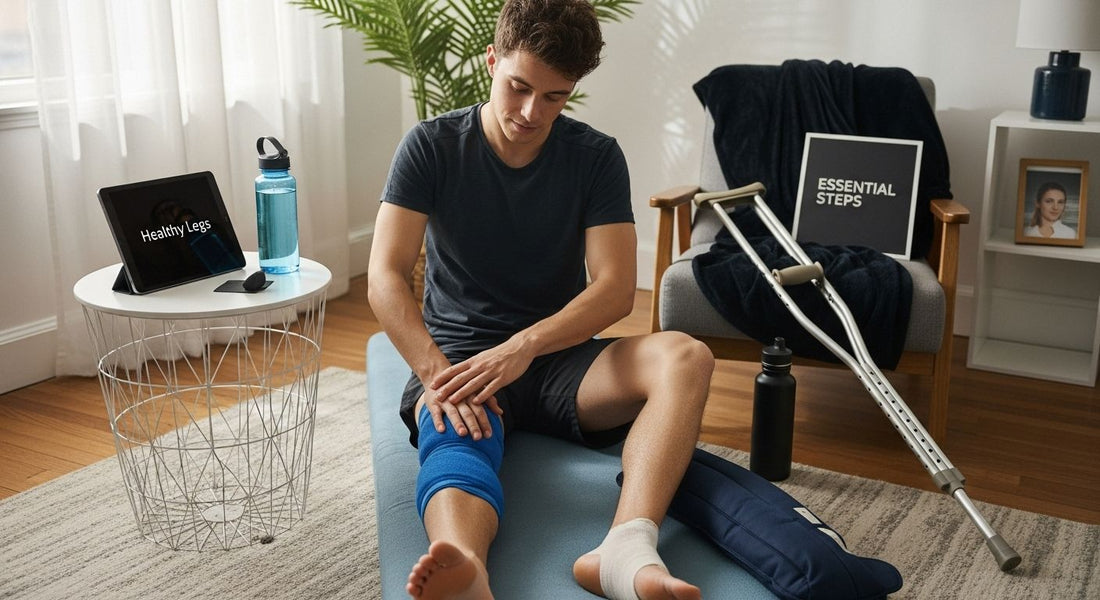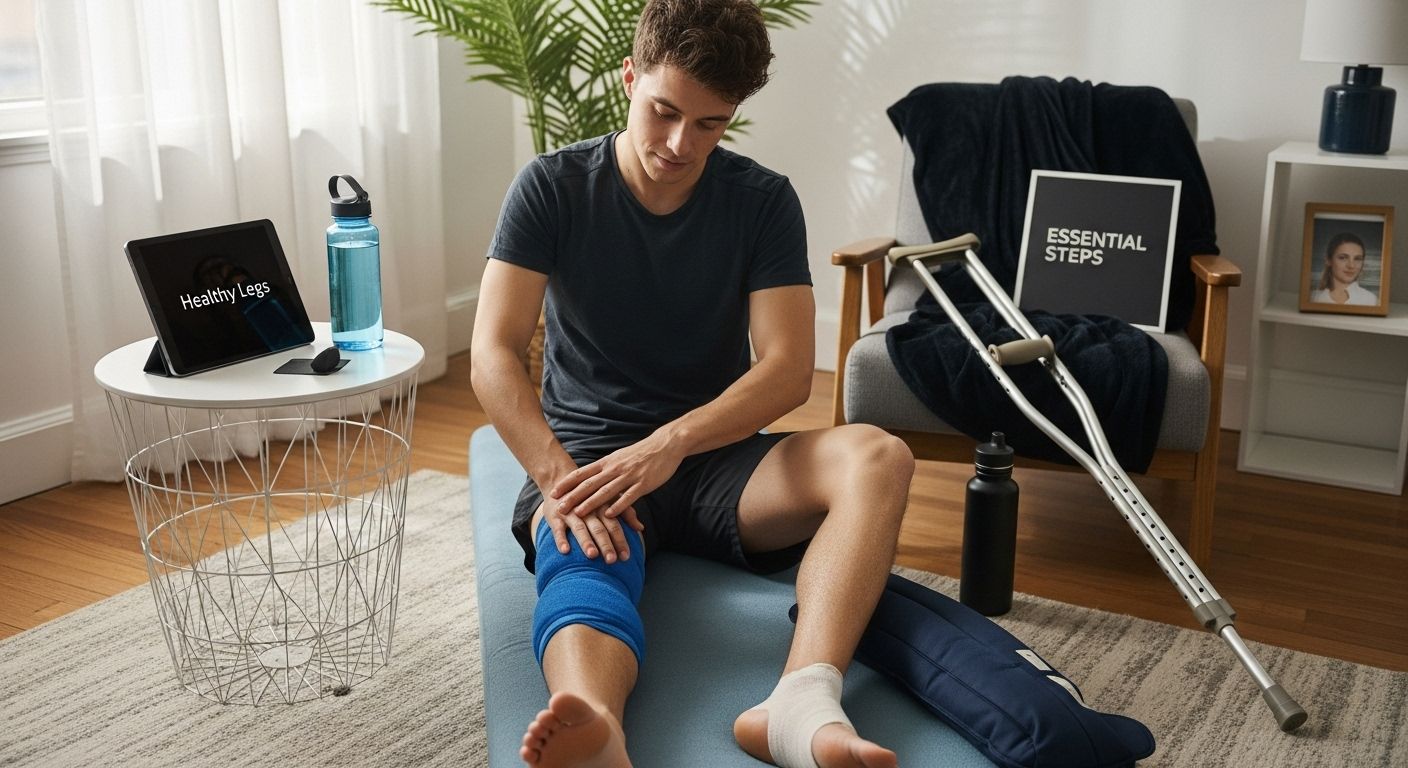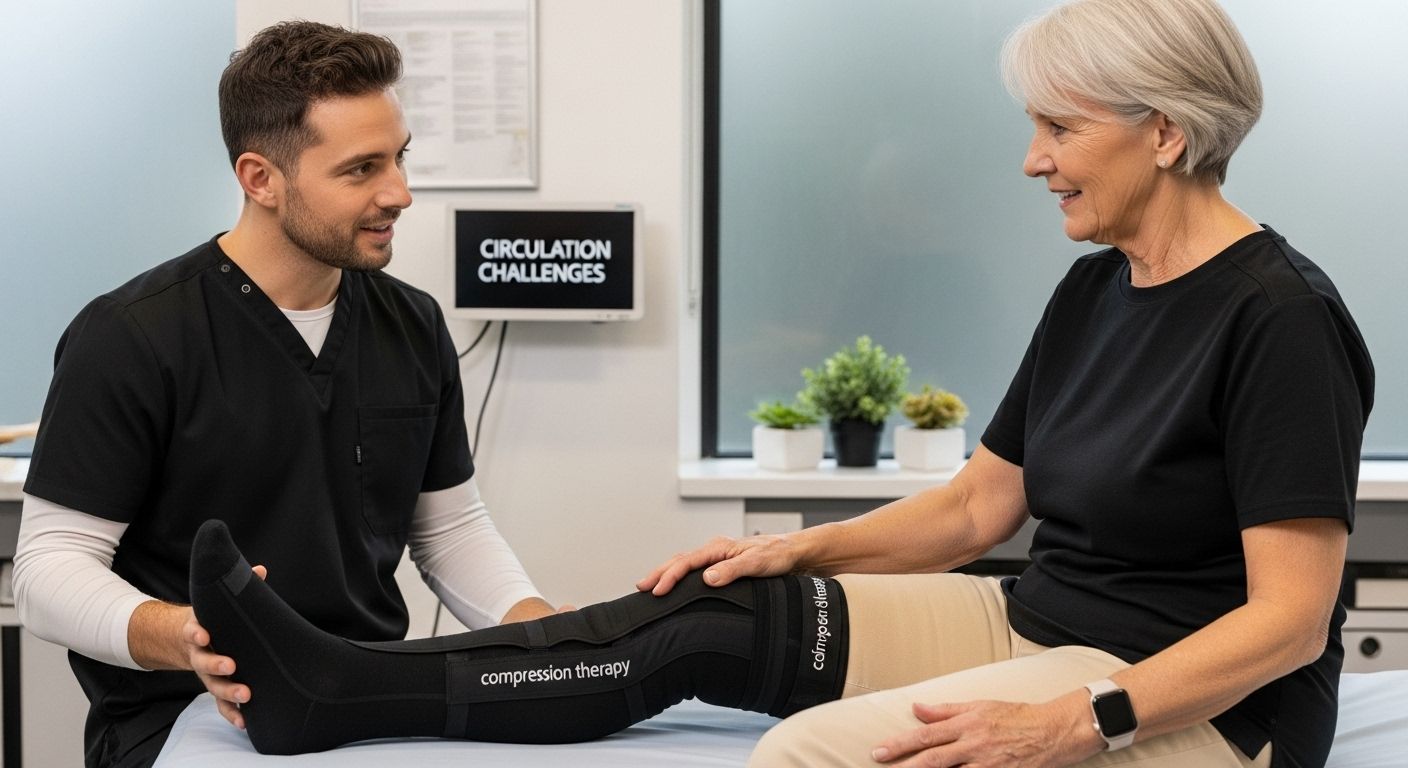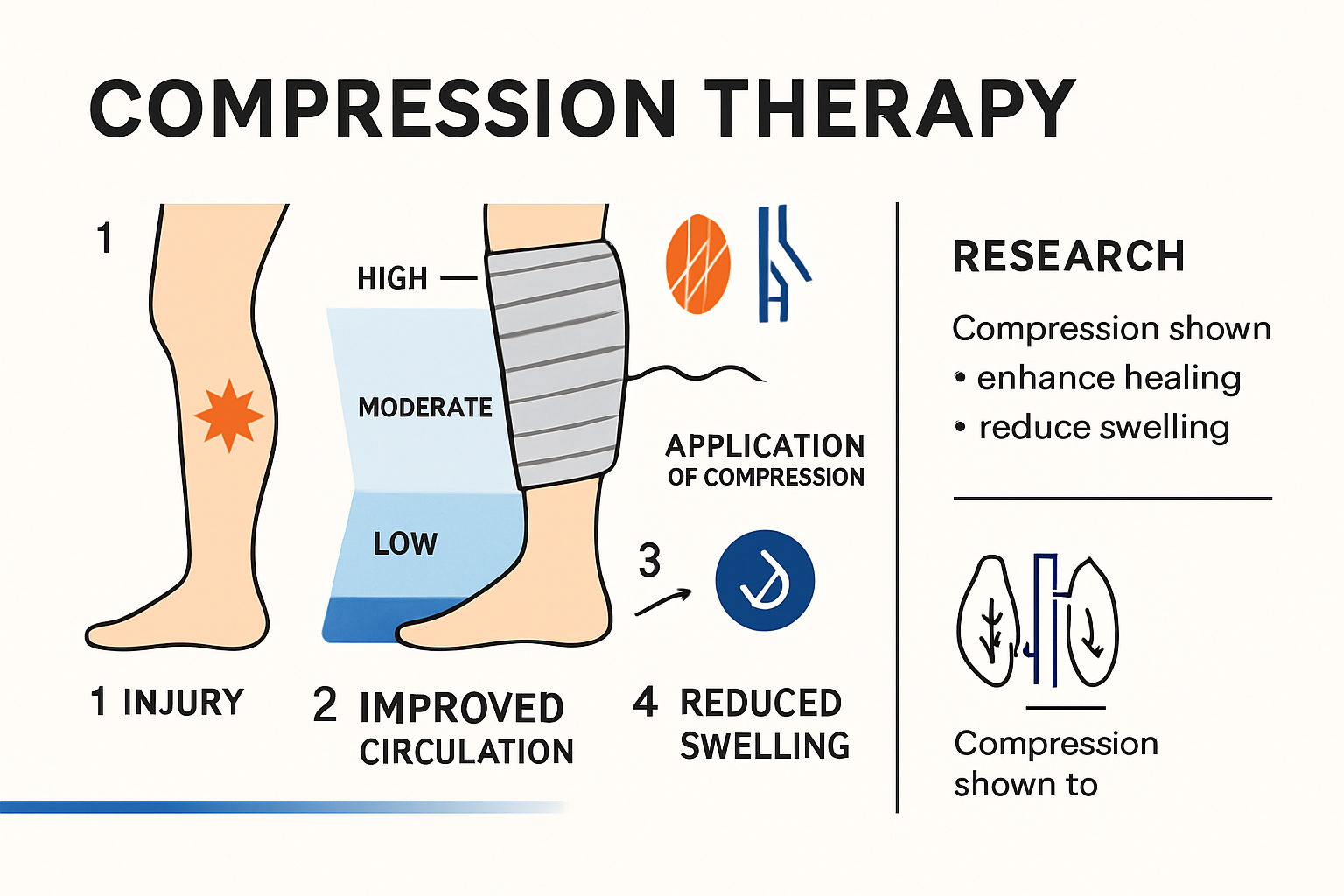
Recovery After Injury: Essential Steps for Healthy Legs
Share

Recovery after a leg injury is never as simple as waiting for the pain to fade and getting back to your daily routine. Most people think swelling and pain just mean you need more rest and ice. Surprising as it sounds, the real gamechanger is circulation—studies show that compression therapy can dramatically speed up healing by improving blood flow and reducing fluid buildup. This flips the usual recovery advice on its head and opens up new ways to get back on your feet faster.
Table of Contents
- Understanding Recovery After Injury And Circulation
- Effective Strategies To Reduce Swelling And Pain
- Role Of Compression Therapy In Healing
- Daily Habits To Support Long-Term Leg Health
Quick Summary
| Takeaway | Explanation |
|---|---|
| Optimize circulation for faster recovery | Effective circulation delivers oxygen and nutrients, essential for healing. Use techniques to enhance blood flow during recovery. |
| Incorporate the R.I.C.E. method | Rest, Ice, Compression, and Elevation significantly reduce swelling and pain to promote healing efficiency. |
| Utilize graduated compression therapy | Compression garments help improve circulation and reduce fluid buildup, critical for recovery from leg injuries. |
| Engage in regular movement and exercise | Consistent exercise enhances muscle strength and flexibility, reducing the risk of future injuries. |
| Monitor and adapt your recovery strategies | Tailor your recovery plan with healthcare professionals, adjusting based on individual injury needs and progress. |
Understanding Recovery After Injury and Circulation
Recovery after injury involves more than just healing visible wounds. The body’s circulatory system plays a critical role in the healing process, particularly for leg injuries where blood flow and tissue repair are interconnected. Understanding how circulation impacts recovery can significantly improve rehabilitation outcomes and prevent potential complications.
The Biological Mechanics of Injury Recovery
When an injury occurs, the body initiates a complex healing cascade that relies heavily on efficient blood circulation. Research published in the Journal of Orthopaedic Surgery and Research highlights that adequate blood flow is essential for delivering oxygen, nutrients, and repair cells to damaged tissues. Without proper circulation, the recovery process slows dramatically, increasing risks of prolonged inflammation, reduced mobility, and potential secondary complications.
The circulatory system serves as the body’s primary transportation network during recovery. White blood cells travel through the bloodstream to fight potential infections, while platelets and growth factors facilitate tissue repair. Restricted blood flow can create bottlenecks in this critical healing process, potentially leading to extended recovery times and reduced overall healing effectiveness.
Circulation Challenges During Leg Injury Recovery
Leg injuries present unique circulation challenges due to gravity and the body’s dependence on leg muscles for efficient blood return. Prolonged immobilization can lead to blood pooling, increased risk of deep vein thrombosis, and muscle atrophy. Graduated compression therapy emerges as a powerful strategy to support healthy circulation during recovery.
Active recovery techniques become crucial in maintaining optimal blood flow. Gentle movements, controlled exercises, and strategic use of compression garments can help stimulate circulation without overexerting injured tissues. Learn more about supporting your recovery with specialized compression techniques.
Patients recovering from leg injuries should work closely with healthcare professionals to develop a circulation-focused rehabilitation plan. This approach not only accelerates healing but also minimizes the risk of long-term circulatory complications. Understanding the intricate relationship between injury, rest, and active circulation management is key to a successful and comprehensive recovery process.

Effective Strategies to Reduce Swelling and Pain
Recovering from a leg injury involves strategic management of pain and swelling to promote faster healing and prevent potential complications. Understanding and implementing targeted techniques can significantly improve recovery outcomes and reduce discomfort during the rehabilitation process.
The R.I.C.E. Method: A Comprehensive Approach
According to the Mayo Clinic, the R.I.C.E. method remains a gold standard for managing injury-related inflammation and pain. This approach encompasses four critical steps: Rest, Ice, Compression, and Elevation. Each component plays a unique role in reducing swelling and supporting the body’s natural healing mechanisms.
Rest involves minimizing movement and stress on the injured area, allowing tissues to begin their repair process. Ice application helps constrict blood vessels, reducing inflammation and numbing pain. Compression provides external support and helps control swelling, while elevation utilizes gravity to minimize fluid accumulation in the injured leg.
Below is a table summarizing the four key steps of the R.I.C.E. injury management method, explaining each step’s main purpose and benefit in the leg injury recovery process.
| Step | Purpose | Main Benefit |
|---|---|---|
| Rest | Minimize movement and stress | Allows tissues to begin repair and prevents further injury |
| Ice | Constrict blood vessels | Reduces inflammation and numbs pain |
| Compression | Provide external support | Controls swelling and supports the injured area |
| Elevation | Use gravity to aid healing | Minimizes fluid accumulation in the injured leg |
Advanced Pain Management Techniques
Harvard Health Publications recommend expanding the traditional R.I.C.E. method to PRICE, which adds Protection as an initial step. Protective measures might include using braces, splints, or supportive wraps to prevent further injury and provide structural support during the initial recovery phase.
Pharmaceutical interventions can complement physical strategies. Non-steroidal anti-inflammatory drugs (NSAIDs) can help manage pain and reduce inflammation. However, patients should consult healthcare professionals to determine the most appropriate pain management strategy for their specific injury.
Compression Therapy: A Modern Recovery Solution
Modern recovery approaches increasingly recognize compression therapy as a powerful tool for managing swelling and supporting healing. Graduated compression garments provide targeted pressure that promotes blood circulation, reduces fluid buildup, and supports injured muscles and joints. Learn more about how compression supports leg recovery.
The National Institute of Arthritis and Musculoskeletal and Skin Diseases emphasizes the importance of a comprehensive approach to injury recovery. While immediate strategies like R.I.C.E. are crucial, long-term rehabilitation involves progressive exercises, careful monitoring, and gradual return to normal activities.
Patients should remember that each injury is unique, and recovery strategies must be tailored to individual needs. Working closely with healthcare professionals ensures a safe, effective recovery process that minimizes pain and supports optimal healing.
Role of Compression Therapy in Healing
Compression therapy emerges as a powerful, scientifically backed approach to support healing and recovery after leg injuries. By applying strategic pressure to injured limbs, this therapeutic technique offers multiple physiological benefits that accelerate the body’s natural healing processes and minimize potential complications.
Physiological Mechanisms of Compression
Research from the National Institutes of Health reveals that compression therapy plays a critical role in managing venous and lymphatic disorders during injury recovery. The technique works by applying graduated pressure that helps improve blood circulation, reduce inflammation, and support tissue repair.
The pressure gradient created by compression garments is designed to be strongest at the ankle and gradually decrease towards the upper leg. This strategic design helps push blood upward against gravity, preventing fluid accumulation and reducing swelling. By promoting better circulation, compression therapy ensures that oxygen and essential nutrients reach injured tissues more efficiently, accelerating the healing process.

Targeted Benefits for Injury Recovery
Compression therapy offers multiple targeted benefits for patients recovering from leg injuries. Graduated compression helps minimize muscle oscillation, reducing fatigue and supporting muscle recovery. The external support provided by compression garments can also help stabilize injured areas, preventing additional strain and promoting proper alignment during healing.
Patients experiencing muscle strains, ligament injuries, or post-surgical recovery can benefit significantly from compression techniques. Explore our comprehensive guide to understanding compression therapy for leg health to learn more about how these specialized garments support rehabilitation.
Selecting the Right Compression Strategy
Choosing appropriate compression involves understanding individual injury characteristics and recovery needs. Medical-grade compression garments come in various pressure levels, typically measured in millimeters of mercury (mmHg). Lower pressure ranges like 15-20 mmHg are suitable for mild swelling and general recovery, while higher pressures such as 20-30 mmHg might be recommended for more significant injuries or post-surgical healing.
Here is a table that compares different compression pressure levels mentioned in the article, highlighting appropriate use cases and target recovery needs for each level. This helps clarify how to select the right compression strategy based on injury severity and recovery goals.
| Compression Level (mmHg) | Recommended Use Case | Target Recovery Need |
|---|---|---|
| 15-20 | Mild swelling, general recovery | Light support and circulation boost |
| 20-30 | More significant injuries, post-surgical | Stronger support, enhanced recovery |
| (Personalized by provider) | Specific to individual anatomy/severity | Tailored to unique recovery goals |
Healthcare professionals can provide personalized guidance on selecting the most appropriate compression level and type of garment. Factors such as injury severity, individual anatomy, and specific recovery goals all influence the ideal compression approach. Patients should always consult with their healthcare provider to develop a tailored compression strategy that supports safe and effective healing.
While compression therapy offers remarkable benefits, it is most effective when integrated into a comprehensive recovery plan that includes proper rest, rehabilitation exercises, and professional medical guidance. By understanding and leveraging the physiological advantages of compression, patients can optimize their healing journey and return to full mobility more efficiently.
Daily Habits to Support Long-Term Leg Health
Maintaining healthy legs extends far beyond injury recovery. Daily habits play a crucial role in preventing future injuries, supporting circulation, and ensuring long-term musculoskeletal wellness. By implementing strategic practices, individuals can significantly enhance their leg health and overall physical resilience.
Movement and Exercise Strategies
Research from the National Institutes of Health emphasizes the importance of consistent muscle strengthening and flexibility work for maintaining leg health. Regular weight-bearing exercises help build muscle strength, improve bone density, and support joint stability. These activities not only prevent future injuries but also enhance overall mobility and circulation.
Incorporating a diverse range of movements is key. This might include low-impact activities like swimming and cycling, strength training with bodyweight or resistance exercises, and flexibility work through stretching and yoga. Discover comprehensive stretching techniques to support leg circulation and comfort to integrate into your daily routine.
Nutrition and Lifestyle Considerations
The American Academy of Orthopaedic Surgeons recommends holistic approaches to leg health that extend beyond physical activity. Proper nutrition plays a critical role in supporting muscle recovery and bone strength. Consuming adequate protein, calcium, vitamin D, and staying hydrated can significantly impact leg muscle and joint health.
Lifestyle choices dramatically influence leg wellness. Avoiding prolonged sedentary periods is crucial for maintaining healthy circulation. Individuals who work desk jobs should incorporate regular movement breaks, use standing desks, or practice simple leg exercises during work hours. Smoking cessation and moderate alcohol consumption also contribute to better leg health by improving overall circulation and reducing inflammation.
Preventative Care and Monitoring
Proactive monitoring and preventative care are essential components of long-term leg health. Regular check-ups with healthcare professionals can help identify potential issues before they become significant problems. This includes assessing muscle strength, checking for early signs of circulatory issues, and developing personalized strategies for maintaining leg wellness.
Wearing appropriate footwear that provides proper support, using compression garments when recommended, and listening to your body’s signals are fundamental preventative strategies. Pay attention to any persistent pain, swelling, or changes in leg sensation, and consult healthcare professionals promptly if concerns arise.
Long-term leg health is a comprehensive journey that requires consistent attention, strategic habits, and a proactive approach. By integrating these daily practices, individuals can support their leg health, reduce injury risks, and maintain optimal mobility throughout their lives. Remember that small, consistent actions compound over time to create significant improvements in overall physical wellness.
Frequently Asked Questions
What is the R.I.C.E. method for injury recovery?
The R.I.C.E. method is an acronym that stands for Rest, Ice, Compression, and Elevation. It is a comprehensive approach to managing injury-related inflammation and pain, promoting faster recovery by minimizing movement, reducing swelling, and aiding healing.
How does compression therapy aid in the recovery process?
Compression therapy supports healing by improving blood circulation, reducing fluid buildup, and stabilizing injured areas. Graduated compression garments apply targeted pressure, which facilitates oxygen and nutrient delivery to damaged tissues, accelerating the healing process.
What are the benefits of using graduated compression garments?
Graduated compression garments help reduce muscle oscillation and fatigue, control swelling, and support proper alignment during recovery. They are especially beneficial for muscle strains, ligament injuries, and post-surgical recovery, enhancing overall rehabilitation outcomes.
How can I select the right compression garment for my injury?
Choosing the right compression garment involves considering your injury’s characteristics and recovery needs. It is important to consult with your healthcare provider to determine the appropriate pressure level and type of garment tailored to your specific injury and recovery goals.
Take the Next Step Toward Faster, Healthier Leg Recovery
Are you feeling frustrated by slow progress or lingering swelling after a leg injury? The article you just read highlights how effective circulation and the right compression therapy can make all the difference in recovery. Fit Stockings understands the challenges of managing pain, reducing swelling, and getting back to your normal routine. With a range of medical-grade compression stockings from trusted brands, we offer solutions designed specifically for injury recovery, varicose veins, lymphedema, and other circulatory issues discussed in the article.
Why wait to experience better support and comfort? Visit Fit Stockings to explore our selection, including graduated compression stockings in multiple styles and strengths. Not sure what you need? Our measuring guide and product education help you choose with confidence. Take action today and give your legs the support they deserve for a healthy comeback.

